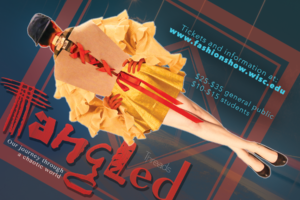The annual “Threads” fashion show, hosted by the School of Human Ecology, displayed a culmination of three semesters’ of hard work this past weekend. The event took place at the Madison Masonic Center Sunday, April 30 with two performances at 4 p.m. and 7 p.m.
“Threads” serves as a platform for students involved in the textiles and fashion design program and allows them to gain real-world fashion experience while still in college. This year’s theme was “Tangled: Our Journey Through A Chaotic World,” an idea that arose from the overabundance of natural disasters that began occurring last year.
Since the show is student-run with the help of SOHE professors, a lot of energy went into putting the show together. “Tangled” was a collaborative effort of students from numerous disciplines including designers, theater specialists, videographers, marketing experts, models and performers.
I was able to learn more about the collaboration and beneficial experience of “Threads” from Maheen Quraishi, a senior studying retail and consumer behavior in SoHE. This is Quraishi’s third year with “Threads” and she worked as the model liaison and assistant creative director.
A whopping 63 models were a part of the production this year.
“We really emphasize that anyone can come and audition. We have zero limitations,” Quraishi said.
The show featured an upbeat selection of runway music for a strong, diverse cast of models.
Qurashi developed many of her organization and communication skills from her time in SoHe and working in these positions. She recognizes the skills she learned over the years of involvement in the show have led her to where she is today.
“Working with designers is one of my favorite things I have gotten to do,” Qurashi said. “Being able to communicate with someone who may have a different mindset and ideas from you has been a great learning experience.”
Along with the collaborative efforts of students from the arts and business schools, the incorporation of other students was necessary as well. Designer Adina Barrientos sought out the help of engineering graduate student Vladimir Bouriakov to combine her textiles with technology and explore the possibilities of 3D and 4D printing.
Countless of the exhibits and individual pieces displayed were unique to each designers’ background and interests. One designer, Emily Popp, fabricated a dress from more than one hundred pounds of discarded clothing. Five models were required to display this piece on the runway.
Her intentions stemmed from moving the audience to question their reasons for owning the clothes they do when most humans retain so much clothing in excess.
Many of the designers’ senior theses were displayed on the runway as well. Sarah Friedland’s collection titled “Sugar-Free” represented the tension young girls often experience between childhood innocence and the harsh realities of life.
Her innovation led to an effortless ability to draw in the audience while providing an element of surprise. Friedland also worked as one of the designer liaisons for this year’s production.
The Badger Herald proudly stands with independent newspapers to #SaveStudentNewsrooms
In order to keep the audience entertained throughout the show, intermittent performances from some of the First Wave Scholars were positioned between runway sets. Obasi Davis, a First Wave collaborator and designer opened the show with a lyrical original. His design collection was also presented.
Another interdisciplinary student, Amanda Graziano, choreographed a dance for the show accompanied by vocals from Hiwot Adilow. Graziano designed her own costume for the performance as part of a larger senior dance thesis.
The event was followed by a reception in which audience members were invited to see some of the senior thesis displays that were not included on the runway. More interactive aspects of the design process were also displayed.
To reform higher education, you must first speak to the students
The students and faculty involved in “Threads” are concerned with the social and environmental impact of their work in addition to the creative aspect. The production focuses on sustainable and ethical products that will create a conscientious transformation in the fashion industry.
“Everything that comes down the runway is more than just fashion — it’s a statement,” Quraishi said. “I think that’s really important for people to be aware of.”


